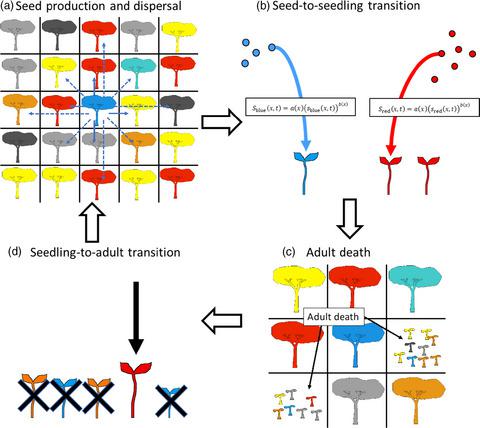Our official English website, www.x-mol.net, welcomes your
feedback! (Note: you will need to create a separate account there.)
Dispersal limitation and weaker stabilizing mechanisms mediate loss of diversity with edge effects in forest fragments
Journal of Ecology ( IF 5.3 ) Pub Date : 2021-02-13 , DOI: 10.1111/1365-2745.13626 Meghna Krishnadas 1, 2 , Simon Maccracken Stump 2, 3
中文翻译:

分散限制和较弱的稳定机制在森林碎片中介导了多样性丧失和边缘效应
更新日期:2021-02-13
Journal of Ecology ( IF 5.3 ) Pub Date : 2021-02-13 , DOI: 10.1111/1365-2745.13626 Meghna Krishnadas 1, 2 , Simon Maccracken Stump 2, 3
Affiliation

|
- Whether fragmented ecosystems can maintain diversity is a key ecological question. The ability of fragmented forests to support diversity is determined by both landscape‐scale metapopulation dynamics and within‐patch mechanisms that govern species coexistence. Within‐patch dynamics can be affected by proximity to forest edges. Edge effects on abiotic and biotic processes can alter species' performance and species interactions, but it is unclear how edge effects bear upon the long‐term ability of fragmented forests to maintain diversity.
- We apply modern coexistence theory as a framework to predict the impact of edge effects on species coexistence. Using field data for a tropical tree community, we parameterized a spatially explicit simulation model to quantify how habitat and density dependence during seedling establishment affect diversity of later life stages. We matched simulated future communities to observed patterns of diversity and community structure for established seedlings and adults, coupled with sensitivity analysis of simulated effects.
- We found that early recruitment dynamics contributed to community structure at older life stages, corroborating empirical work on the importance of early life‐stage dynamics for diversity. Edge effects reduced the diversity maintained in patches. The progressive loss of diversity was not due to changes in relative competitive ability (fitness differences), but due to weaker stabilization via density‐dependent seed mortality. Results were robust to wide changes in the absolute values of model parameters, suggesting that variation in the strength of individual processes did not change their relative importance for diversity.
- Synthesis. Weakening of stabilizing processes that promote species self‐limitation in ecological communities could compromise the ability of habitat fragments to maintain diversity. Quantifying the relative importance of intraspecific versus interspecific interactions—to assess stabilizing mechanisms and fitness differences—can help evaluate when habitat amount versus quality plays a larger role in maintaining diversity of fragments.
中文翻译:

分散限制和较弱的稳定机制在森林碎片中介导了多样性丧失和边缘效应
- 零散的生态系统能否维持多样性是一个关键的生态问题。支离破碎的森林支持多样性的能力取决于景观规模的种群动态和支配物种共存的斑块内机制。斑块内的动态可能会受到靠近森林边缘的影响。非生物和生物过程的边缘效应可以改变物种的性能和物种相互作用,但是尚不清楚边缘效应如何影响零散森林维持多样性的长期能力。
- 我们将现代共存理论作为框架来预测边缘效应对物种共存的影响。使用热带树木群落的现场数据,我们对空间明确的模拟模型进行了参数化,以量化幼苗建立过程中的栖息地和密度依赖性如何影响后期生活阶段的多样性。我们将模拟的未来群落与已观察到的幼苗和成虫的多样性和群落结构的观察模式进行了匹配,并结合了模拟效应的敏感性分析。
- 我们发现,早期招聘动态有助于老年人生命周期的社区结构,从而证实了早期生命动态对于多样性的重要性的实证研究。边缘效应降低了补丁中维持的多样性。多样性的逐步丧失不是由于相对竞争能力的变化(适应性差异),而是由于依赖于密度的种子死亡率导致的稳定性较弱。结果对于模型参数的绝对值的广泛变化都具有鲁棒性,表明各个过程的强度变化不会改变其对多样性的相对重要性。
- 综合。削弱促进生态群落中物种自我限制的稳定过程可能会破坏栖息地碎片维持多样性的能力。量化种内相互作用与种间相互作用的相对重要性,以评估稳定机制和适应性差异,可以帮助评估何时栖息地数量与质量在维持片段多样性方面起更大的作用。











































 京公网安备 11010802027423号
京公网安备 11010802027423号